Development of an Event-Based Water Quality Model for Sparsely Gauged Catchments
Abstract
1. Introduction
2. Model Development
2.1. Hydrology Module
2.2. Erosion Module
2.2.1. Sediment Supply
Sediment Caused by Rainfall
Sediment Caused by Runoff
2.2.2. Sediment Transport Capacity
2.3. Nutrient Loading Module
2.4. River Routing and Point Sources
2.5. Model Uncertainty
3. Application
3.1. Study Area
3.2. Model Set-Up
3.3. Calculation of Model Parametes
3.3.1. Hydrologic Calculations
3.3.2. Erosion and Sediment Calculation
3.3.3. Nutrient Loading Calculation
3.3.4. River Routing Calculation
4. Results and Discussions
4.1. Sensitivity Analysis
4.2. Model Results
4.3. Model Uncertainty Analysis
5. Conclusions
Author Contributions
Funding
Acknowledgments
Conflicts of Interest
Appendix A
| Class No | Class Type | Typical Land Code | GC | CF |
|---|---|---|---|---|
| Class 6 | Impervious | UrRe | 0.1 | 0.9 |
| Bare ground | UrGd | 0.1 | 0.9 | |
| Forests | NUWod | 0.8 | 0.4 | |
| Crops LowVeg | NUSg | 0.5 | 0.6 | |
| Wetlands | NUWe | 0.6 | 0.5 | |
| Water | NUWa | 0 | 0 | |
| Class 10 | Impervious | UrRe | 0.1 | 0.9 |
| Bare ground light | NUFf | 0.1 | 0.9 | |
| Bare ground dark | UrTs | 0.2 | 0.85 | |
| Forests light | NUWol | 0.8 | 0.35 | |
| Forests dense | NUWod | 0.9 | 0.3 | |
| Grass | NUGr | 0.5 | 0.6 | |
| Crops low | NUSg | 0.6 | 0.5 | |
| Crops high | NURc | 0.7 | 0.4 | |
| Wetlands | NUWe | 0.6 | 0.5 | |
| Water | NUWa | 0 | 0 |
| SCS Code | Soil Class | HSC | SText | K | D50 | σ |
|---|---|---|---|---|---|---|
| s | Sand | A | 1 | 0.01 | 0.11 | 2.455 |
| ls | Loamy sand | A | 1 | 0.05 | 0.13 | 2.293 |
| sl | Sandy loam | B | 1 | 0.14 | 0.105 | 2.111 |
| l | Loam | B | 2 | 0.01 | 0.075 | 2.009 |
| sil | Silt loam | C | 2 | 0.37 | 0.035 | 2.099 |
| s | Silt | C | 2 | 0.42 | 0.005 | 1.920 |
| scl | Sandy clay loam | B | 1 | 0.22 | 0.33 | 1.949 |
| cl | Clay loam | C | 3 | 0.29 | 0.31 | 1.857 |
| sicl | Silt clay loam | C | 2 | 0.31 | 0.038 | 1.977 |
| sc | Sandy clay | B | 1 | 0.15 | 0.55 | 1.849 |
| sic | Silty clay | C | 3 | 0.24 | 0.1 | 1.920 |
| c | clay | D | 3 | 0.2 | 0.61 | 1.840 |
| Evaluation Parameter | Equation | Reference | |
|---|---|---|---|
| 1 | Nash–Sutcliffe efficiency, (NSE) | [57,63] | |
| 2 | Index of agreement, d | [57,64] | |
| 3 | Coefficient of determination, R2 | [57,64] | |
| 4 | Percentage bias (PBIAS) | [57,64] |
| NSE: The Nash–Sutcliffe efficiency is a normalized statistic, indicating how well the plot of observed versus simulated data fits the 1:1 line. It ranges between −∞ and 1.0 (1 inclusive), with NSE = 1 as the optimal value. Values between 0.0 and 1.0 are generally viewed as acceptable levels of performance. |
| d: The index of agreement is a standardized measure of degree of model prediction error and varies between 0 and 1. A computed value of 1 indicates a perfect agreement between the measured and predicted values, and 0 indicates no agreement at all. |
| R2: The coefficient of determination describes the degree of collinearity between simulated and measured data, ranging from 0 to 1 with higher values indicating less error variance. |
| PBIAS: Percent bias measures the average tendency of the simulated data to be larger than the observed counterparts. The optimal value of PBIAS is 0.0, with low-magnitude values indicating accurate model simulation. Positive values indicate model underestimation bias, and negative values indicate model overestimation bias. |
| Ratios | Formula | Notes |
|---|---|---|
| Bifurcation | where Ni and Ni+1 are the number of streams in order i and i + 1. Let Ω represent the highest stream order in catchment, i = 1, 2, …, Ω. | |
| Length | is the average length of channels of order I, where | |
| Area | is the mean area of the contributing sub-catchment to streams of order i, , where Ai,j represents the total area that drains into the jth stream of order i |
| NSE | d | R2 | PBIAS | |
|---|---|---|---|---|
| Runoff Flow | 0.95 | 0.98 | 0.89 | −6.98 |
| TSS | 0.65 | 0.92 | 0.65 | 27.35 |
| P-PO4 | 0.61 | 0.86 | 0.61 | 3.92 |
| N-NH4 | 0.60 | 0.87 | 0.60 | −11.92 |
| N-NO3 | −0.03 | 0.832 | 0.56 | 1.01 |
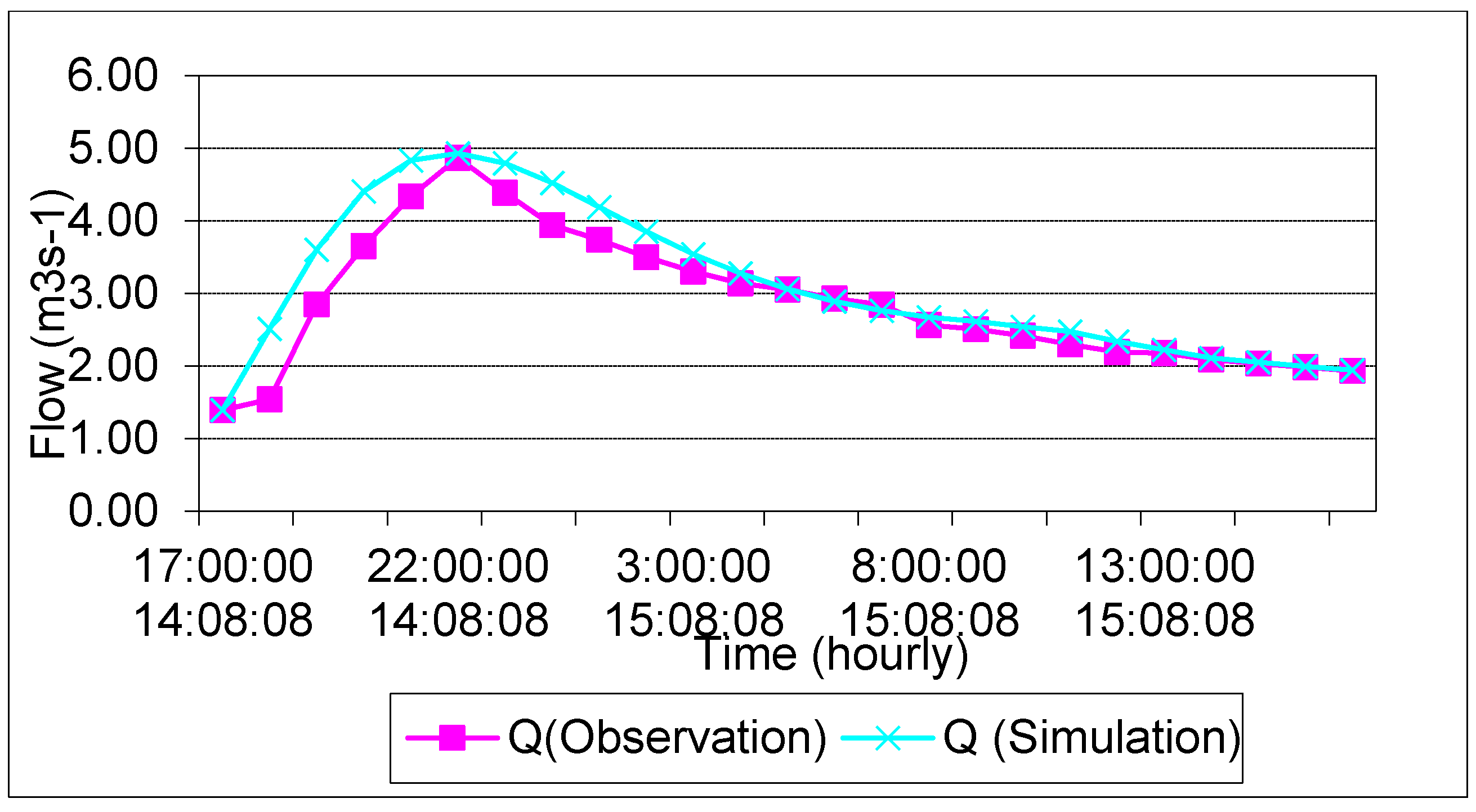

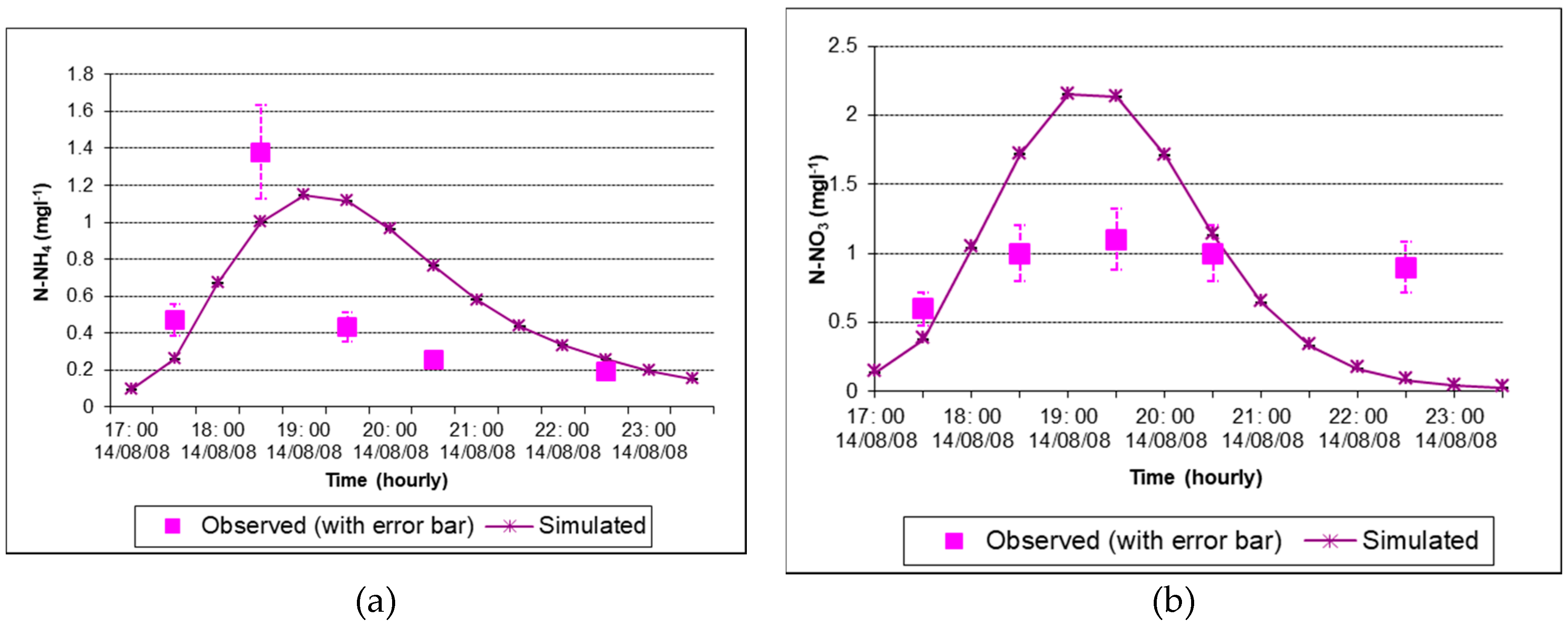
References
- Novotny, V. Water Quality: Diffuse Pollution and Watershed Management, 2nd ed.; John Wiley and Sons: Hoboken, NJ, USA, 2002; p. 888. [Google Scholar]
- Loague, K.; Corwin, D.L. Point and nonpoint source pollution. In Encyclopedia of Hydrological Sciences; Anderson, M.G., Ed.; Wiley & Sons: Chichester, UK, 2005; Volume 3, pp. 1427–1439. [Google Scholar]
- Quan, N.H.; Meon, G. Nutrient Dynamics During Flood Events in Tropical Catchments: A Case Study in Southern Vietnam. Clean Soil Air Water 2014, 43, 652–661. [Google Scholar] [CrossRef]
- NRC. Assessing the TMDL Approach to Water Quality Management. Committee to Assess the Scientific Basis of the Total Maximum Daily Load Approach to Water Pollution Reduction, Water Science and Technology Board. National Research Council (NRC); National Academy of Sciences: Washington, DC, USA, 2001.
- Beven, K. Rainfall-Runoff Modelling: The Primer; John Wiley and Sons: Hoboken, NJ, USA, 2000; p. 360. [Google Scholar]
- Borah, D.K.; Bera, M. Watershed-scale hydrologic and nonpoint-source pollution models: Review of applications. Trans. ASAE 2003, 47, 789–803. [Google Scholar] [CrossRef]
- Kämäri, J.; Boorman, D.; Icke, J.; Perrin, C.; Candela, L.; Lorza, F.J.; Ferrier, R.C.; Bakken, T.H.; Hutchins, M. Process for benchmarking models: Dialogue between water managers and modellers. In Benchmarking Models for the Water Framework Directive (Large Rivers Vol. 17 No. 1-2); Arch.hydrobiol. Suppl.161/1-2; E. Schweizerbart’sche Verlagsbuchhandlung: Stuttgart, Germany, 2006; pp. 3–21. [Google Scholar]
- Boorman, D.B.; Williams, R.J.; Hutchins, M.J.P.E.; Groot, S.; Icke, J. A model selection protocol to support the use of models for water management. Hydrol. Earth Syst. Sci. 2007, 11, 634–646. [Google Scholar] [CrossRef]
- Saloranta, T.M.; Kämäri, J.; Rekolainen, S.; Malve, O. Benchmark Criteria: A Tool for Selecting Appropriate Models in the Field of Water Management. Environ. Manag. 2003, 32, 322–333. [Google Scholar]
- Kundzewicz, Z.W. Prediction in ungauged basins—A systemic perspective. In Predictions in Ungauged Basins: PUB Kick-Off, Proceedings of the PUB Kick-Off Meeting, Brasilia, Brazil, 20–22 November 2002; Schertzer, D., Hubert, P., Koide, S., Takeuchi, K., Eds.; IAHS Publ. 309: Wallingford, UK, 2007. [Google Scholar]
- Peters, N.E.; Reynolds, B.; Johnes, P.J. Uncertainty of water-quality predictions in ungauged basins (PUBS). In Predictions in Ungauged Basins: PUB Kick-Off, Proceedings of the PUB Kick-Off Meeting, Brasilia, Brazil, 20–22 November 2002; Schertzer, D., Hubert, P., Koide, S., Takeuchi, K., Eds.; International Association of Hydrological Sciences (IAHS Publication 309): Wallingford, UK, 2007; pp. 63–73. [Google Scholar]
- Campling, P.; Gobin, A.; Beven, K.; Feyen, J. Rainfall-runoff modelling of a humid tropical catchment: The TOPMODEL approach. Hydrol. Process. 2002, 16, 231–253. [Google Scholar] [CrossRef]
- Marsik, M.; Waylen, P. An application of the distributed hydrologic model CASC2D to a tropical montane watershed. J. Hydrol. 2006, 330, 481–495. [Google Scholar] [CrossRef]
- Diaz-Ramirez, J.N.; Perez-Alegria, L.R.; McAnally, W.H. Hydrology and Sediment Modeling Using HSPF/BASINS in a Tropical Island Watershed. Trans. ASABE 2008, 51, 1555–1565. [Google Scholar] [CrossRef]
- Polyakov, V.; Fares, A.; Kubo, D.; Jacobi, J.; Smith, C. Evaluation of a non-point source pollution model, AnnAGNPS, in a tropical watershed. Environ. Model. Softw. 2007, 22, 1617–1627. [Google Scholar] [CrossRef]
- Maimer, A. Hydrological effects and nutrient losses of forest plantation establishment on tropical rainforest land in Sabah, Malaysia. J. Hydrol. 1996, 174, 129–148. [Google Scholar]
- Kang, B.T.; Lal, R. Nutrient losses in water runoff from agricultural catchments. In Tropical Agricultural Hydrology. Watershed Management and Land Use; Lal, R., Russell, E.W., Eds.; Wiley: Chichester, UK, 1981; pp. 119–130. [Google Scholar]
- Lorenz, M.; Prilop, K.; Thang, M.T.; Le, H.; Hieu, N.D.; Meon, G.; Quan, N.H. Ecohydrological modeling of the Thi Vai Catchment in South Vietnam. In EWATEC-COAST: Technologies for Environmental and Water Protection of Coastal Zones in Vietnam. Contributions to the 4th International Conference for Environment and Natural Resources, ICENR 2014; Meon, G., Pätsch, M., Phuoc, N.V., Quan, N.H., Eds.; Cuvillier: Göttingen, Germany, 2014; pp. 83–96. [Google Scholar]
- Meon, G.; Lorenz, M.; Koch, A.; Le, T.T.H.; Pätsch, M.; Zeunert, A.; Nguyen, H.Q. Entwicklung einer Basisversion eines Managementsystems für die regionale Wasserwirtschaft einer Küstenzone in Vietnam (Development of a basic version of a management system for the regional water resources management of a coastal zone in Vietnam). Hydrol. Wasserbewirtsch. 2017, 61, 437–449. [Google Scholar]
- Nguyen, H.Q.; Maathuis, B.; Rientjes, T. Catchment storm runoff modelling using the Geomorphologic Instantaneous Unit Hydrograph. Geocarto Int. 2009, 24, 357–375. [Google Scholar] [CrossRef]
- Rodríguez-Iturbe, I.; Valdez, J.B. The geomorphologic structure of hydrology response. Water Resour. Res. 1979, 15, 1409–1420. [Google Scholar] [CrossRef]
- Gupta, V.K.; Waymire, E.; Wang, C.T. A representation of an Instantaneous Unit Hydrograph from Geomorphology. Water Resour. Res. 1980, 16, 855–862. [Google Scholar] [CrossRef]
- Nguyen, H.Q.; Maathuis, B.H.P.; Rientjes, T.H.M. Utilization of SRTM data for flood protection based on GIUH approach. Rev. Geogr. Acad. 2008, 2, 14–25. [Google Scholar]
- Al-Wagdany, A.S.; Rao, A.R. Correlation of velocity parameter of three geomorphological instantaneous unit hydrograph models. Hydrol. Process. 1998, 12, 651–659. [Google Scholar] [CrossRef]
- Rodríguez-Iturbe, I. The geomorphological Unit Hydrograph. In Channel Network Hydrology; Beven, K., Kirby, M.J., Eds.; John Wiley & Sons: Hoboken, NJ, USA, 1993; p. 319. [Google Scholar]
- Tuong, N.V. Studying on application of flooding geomorphological Unit Hydrograph in some catchments in Vietnam. Meterol. Hydrol. Vietnam. Meterol. Hydrol. Gen. Agency 1997, 3, 22–27. (In Vietnamese) [Google Scholar]
- Bhaskar, N.R.; Parida, B.P.; Nayak, A.K. Flood estimation for Ungauged catchment using the GIUH. J. Water Resour. Plan. Manag. 1997, 123, 228–238. [Google Scholar] [CrossRef]
- ITC. ILWIS 3.0 Academic: User’s Guide; International Institute for Geo-Information Science and Earth Observation (ITC): Enschede, The Netherlands, 2001; p. 530.
- Ogrosky, O.H.; Mockus, V. Section 21: Hydrology of agricultural lands. In Handbook of Applied Hydrology: A Compendium of Water Resources Technology; Chow, V.T., Ed.; McGraw-Hill: New York, NY, USA, 1964; pp. 21/1–21/97. [Google Scholar]
- Chow, V.T.; Maidment, D.R.; Larry, W.M. Applied Hydrology; McGraw-Hill: New York, NY, USA, 1988; p. 572. [Google Scholar]
- Hartley, D.M. Simplified Process Model for Water Sediment Yield from Single Storms Part I: Model Formulation. Am. Soc. Agric. Eng. Trans. ASAE 1987, 30, 710–717. [Google Scholar] [CrossRef]
- Hartley, D.M. Simplified Process Model for Water Sediment Yield from Single Storms Part II: Performance. Am. Soc. Agric. Eng. Trans. ASAE 1987, 30, 718–723. [Google Scholar] [CrossRef]
- León, L.F.; Soulis, E.D.; Kouwen, N.; Farquhar, G.J. Nonpoint source pollution: A distributed water quality modeling approach. Water Res. 2001, 35, 997–1007. [Google Scholar] [CrossRef]
- Nearing, M.A.; Norton, L.D.; Zhang, X. Soil Erosion and Sedimentation. In Agricultural Nonpoint Source Pollution: Watershed Management and Hydrology; Ritter, W., Shirmohammadi, A., Eds.; Lewis: Boca Raton, FL, USA, 2001; pp. 29–58. [Google Scholar]
- Wishmeier, W.H.; Smith, D.D. Predicting Rainfall Erosion Losses: A Guide to Conservation Planning; Agriculture Handbook No. 537; US. Dep. of Agriculture: Washington, DC, USA, 1978; 58p.
- Young, R.A.; Onstad, C.A.; Bosch, D.D. Chapter 26: AGNPS: Agricultural Non-Point Source Pollution Model. In Computer Models of Watershed Hydrology; Singh, V.P., Ed.; Water Resources Publication: Highlands Ranch, CO, USA, 1995; pp. 1001–1020. [Google Scholar]
- Haith, D.A.; Tubbs, L.J. Watershed Loading Functions for Nonpoint Sources. J. Environ. Eng. 1981, 107, 121–137. [Google Scholar]
- Haith, D.A.; Tubbs, L.J.; Pickering, N.B. Simulation of Pollution by Soil Erosion and Soil Nutrient Loss; PUDOC Publishers: Wageningen, The Netherlands, 1984; p. 77. [Google Scholar]
- Haith, D.R.; Mandel, R.; Wu, R.S. GWLF: Generalized Watershed Loading Functions. User’s Manual, Version 2.0; Cornell University: Ithaca, NY, USA, 1992; p. 64. [Google Scholar]
- Knisel, W.G.; Leonard, R.A.; Davis, F.M. (Eds.) GLEAMS Version 2.1 Part I: Nutrient Component Documentation; Publication Nr. 5; University of Georgia, Coastal Plain Experiment Station, Biological and Agricultural Engineering Department: Tifton, GA, USA, 1993; p. 259. [Google Scholar]
- Knisel, W.G.; Walter, G. (Eds.) CREAMS: A Field Scale Model for Chemicals, Runoff, and Erosion from Agricultural Management Systems; Report No. 26; U.S. Department of Agriculture, Conservation: Washington, DC, USA, 1980; p. 640.
- Arnold, J.; Williams, A.; Srinivasan, R.; King, B.; Griggs, A. SWAT, Soil and Water Assessment Tool; ARS, USDA: Temple, TX, USA, 1994.
- Beasley, D.B.; Huggins, L.F.; Monke, E.J. ANSWERS: A model for watershed planning. Trans. ASAE 1980, 23, 938–944. [Google Scholar] [CrossRef]
- Bouraoui, F.; Braud, I.; Dillaha, T.A. ANSWERS: A nonpoint source pollution model for water, sediment and nutrient losses. In Mathematical Models of Small Watershed Hydrology and Applications; Singh, V.P., Frevert, D.K., Eds.; Water Resources Publication, LLC: Highlands Ranch, CO, USA, 2002; pp. 833–882. [Google Scholar]
- Novotny, V.; Olem, H. Modeling and monitoring diffuse pollution. In Water Quality: Prevention, Identification, and Management of Diffuse Pollution; Van Nostrand Reinhold: New York, NY, USA, 1994; pp. 507–571. [Google Scholar]
- Chu, Y.; Salles, C.; Cernesson, F.; Perrin, J.L.; Tournoud, M.G. Nutrient load modelling during floods in intermittent rivers: An operational approach. Environ. Model. Softw. 2008, 23, 768–781. [Google Scholar] [CrossRef]
- Vose, D. Quantitative Risk Analysis: A Guide to Monte Carlo Simulation Modelling; Wiley: Chichester, UK, 1996; p. 328. [Google Scholar]
- VEPA. Environment Report of Vietnam “The State of Water Environment in 3 River Basins of Cau, Nhue-Day, Dong Nai River System”; Vietnam Environment Protection Agency (VEPA): Hanoi, Vietnam, 2005; p. 92. [Google Scholar]
- TN DOSTE. Characteristics of Climate, Hydrology in Tay Ninh; Tay Ninh Department of Science, Technology and Environment (TN DOSTE): Tay Ninh, Vietnam, 2000; p. 140. (In Vietnamese) [Google Scholar]
- Huynh, N.P.M. Integrated Treatment of Tapioca Processing Industrial Wastewater: Based on Environmental Bio-Technology. Ph.D. Thesis, Wageningen University, Wageningen, The Netherlands, 2006. [Google Scholar]
- Maathuis, B.H.P.; Wang, L. Digital elevation model based hydro-processing. Geocarto Int. 2006, 21, 21–26. [Google Scholar] [CrossRef]
- Strahler, A.N. Quantitative geomorphology of drainage basins and channel network. In Handbook of Applied Hydrology: A Compendium of Water Resources Technology; Chow, V.T., Ed.; McGraw-Hill: New York, NY, USA, 1964; pp. 439–476. [Google Scholar]
- Nguyen, H.Q. Rainfall-Runoff Modelling for the Ungauged Canle Catchment, Sai Gon River Basin; MsC International Institute for Geo-information Science and Earth Observation (ITC): Enschede, The Netherlands, 2006.
- McCuen, R.H. Hydrologic Analysis and Design, 2nd ed.; Prentice-Hall: Englewood Cliffs, NJ, USA, 1998; p. 814. [Google Scholar]
- Harmel, R.D.; Cooper, R.J.; Slade, R.M.; Haney, R.L.; Arnold, J.G. Cumulative uncertainty in measured streamflow and water quality data for small watersheds. Trans. ASABE 2006, 49, 689–701. [Google Scholar] [CrossRef]
- Willmott, C.J. On the evaluation of model performance in physical geography. In Spatial Statistics and Models; Gaile, G.L., Willmott, C.J., Eds.; D. Reidel Publishing Dordrecht: Boston, MA, USA, 1984; pp. 443–459. [Google Scholar]
- Moriasi, D.N.; Arnold, J.G.; Van Liew, M.W.; Bingner, R.L.; Harmel, R.D.; Veith, T.L. Model evaluation guidelines for systematic quantification of accuracy in watershed simulations. Trans. ASABE 2007, 50, 885–900. [Google Scholar] [CrossRef]
- US EPA. BASINS 4 Lectures, Data Sets, and Exercises. Available online: http://www.epa.gov/waterscience/basins/training.htm (accessed on 3 February 2009).
- León, L.F. Integral System for Nonpoint Source Pollution Modeling in Surface Waters. Ph.D. Thesis, University of Waterloo, Waterloo, ON, Canada, 1999. [Google Scholar]
- Kundzewicz, Z.W. Mathematical modelling of ecohydrological systems in the changing world. In Wetlands: Monitoring, Modelling and Management; Okruszko, T., Maltby, E., Szatyłowicz, J., Świątek, D., Kotowski, W., Eds.; Taylor and Francis: London, UK, 2007; pp. 151–159. [Google Scholar]
- Savenije, H.H.G. HESS Opinions “The art of hydrology”. Hydrol. Earth Syst. Sci. 2009, 13, 157–161. [Google Scholar] [CrossRef]
- Brugnach, M.; Pahl-Wostl, C. A broadened view on the role for models in natural resource management: Implications for model development. In Adaptive and Integrated Water Management: Coping with Complexity and Uncertainty; Pahl-Wostl, C., Kabat, P., Möltgen, J., Eds.; Springer: Berlin/Heidelberg, Germany, 2008; pp. 187–203. [Google Scholar]
- Nash, J.E.; Sutcliffe, J.V. River flow forecasting through conceptual models. Part I: A discussion of principles. J. Hydrol. 1970, 10, 282–290. [Google Scholar] [CrossRef]
- Legates, D.R.; McCabe, G.J. Evaluating the use of “goodness-of-fit” measures in hydrologic and hydroclimatic model validation. Water Resour. Res. 1999, 35, 233–241. [Google Scholar] [CrossRef]
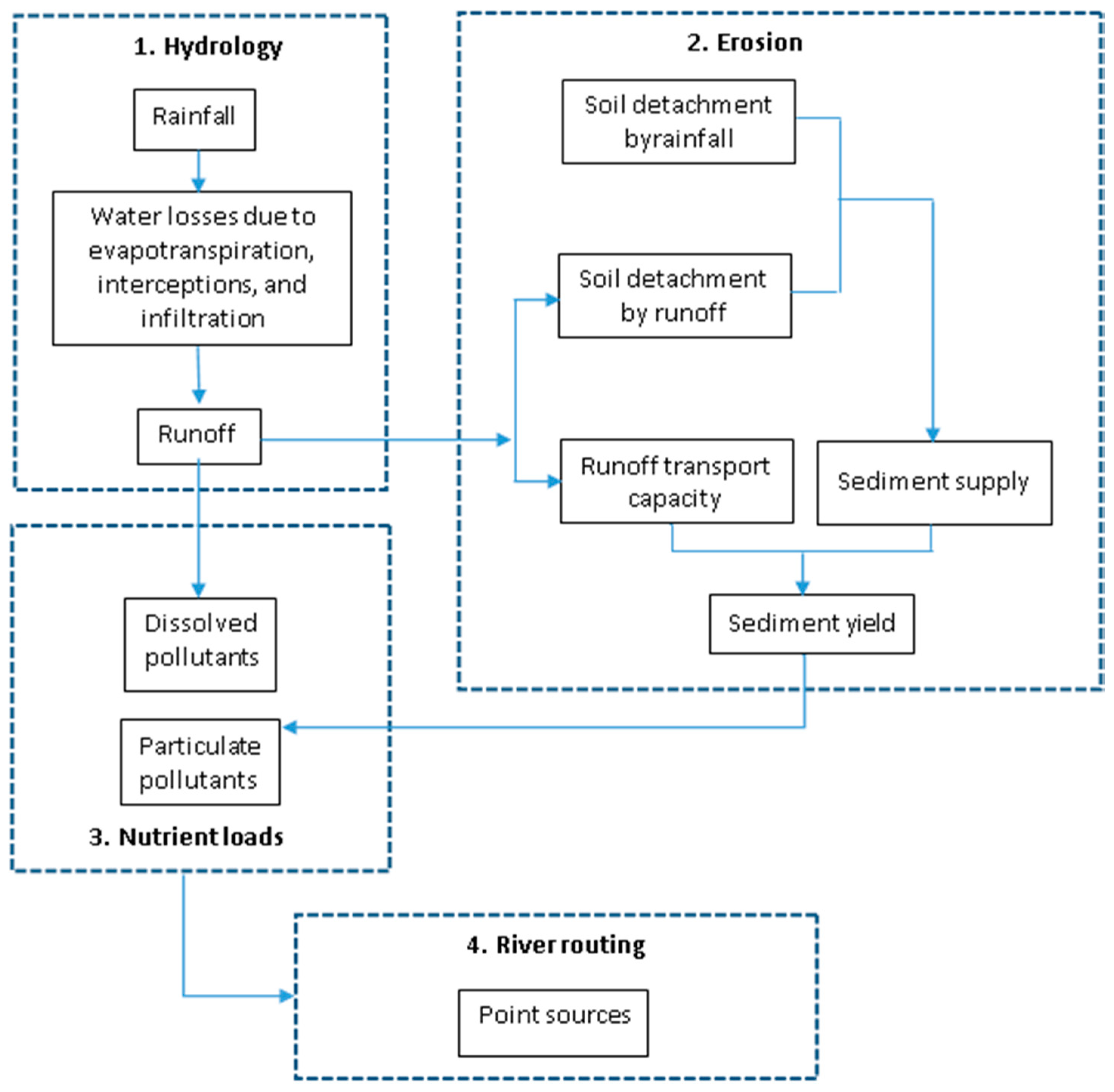
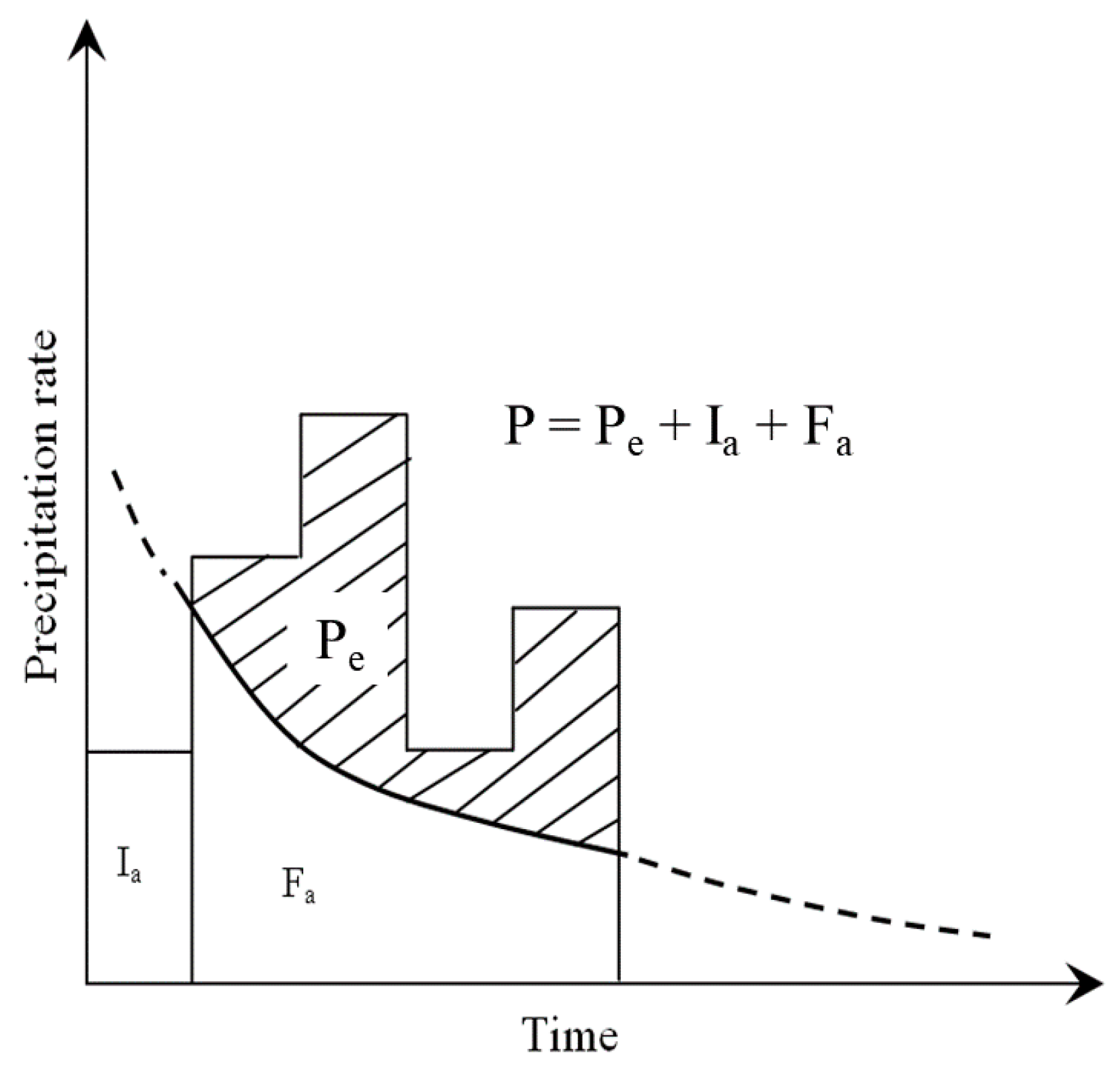
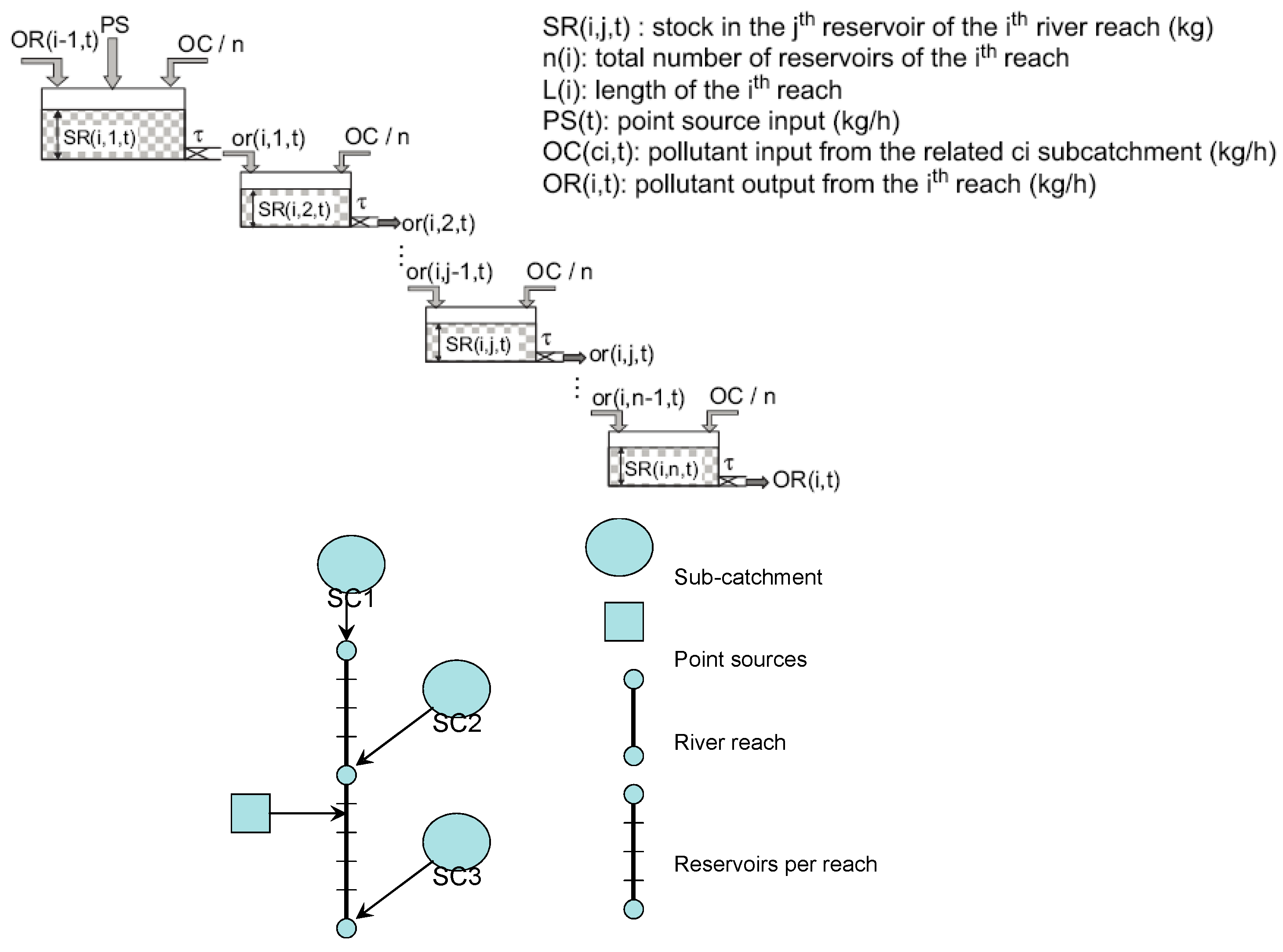
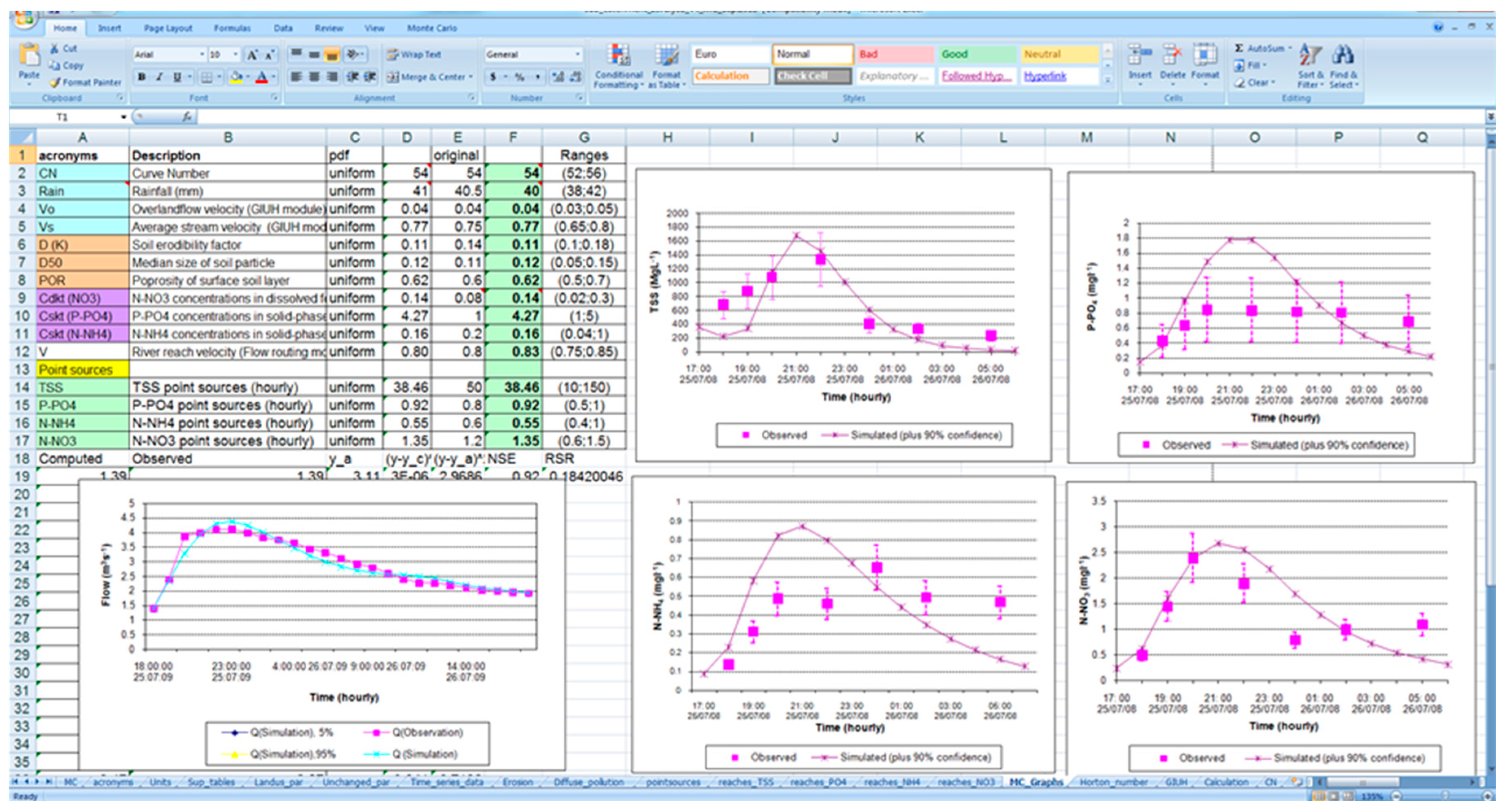
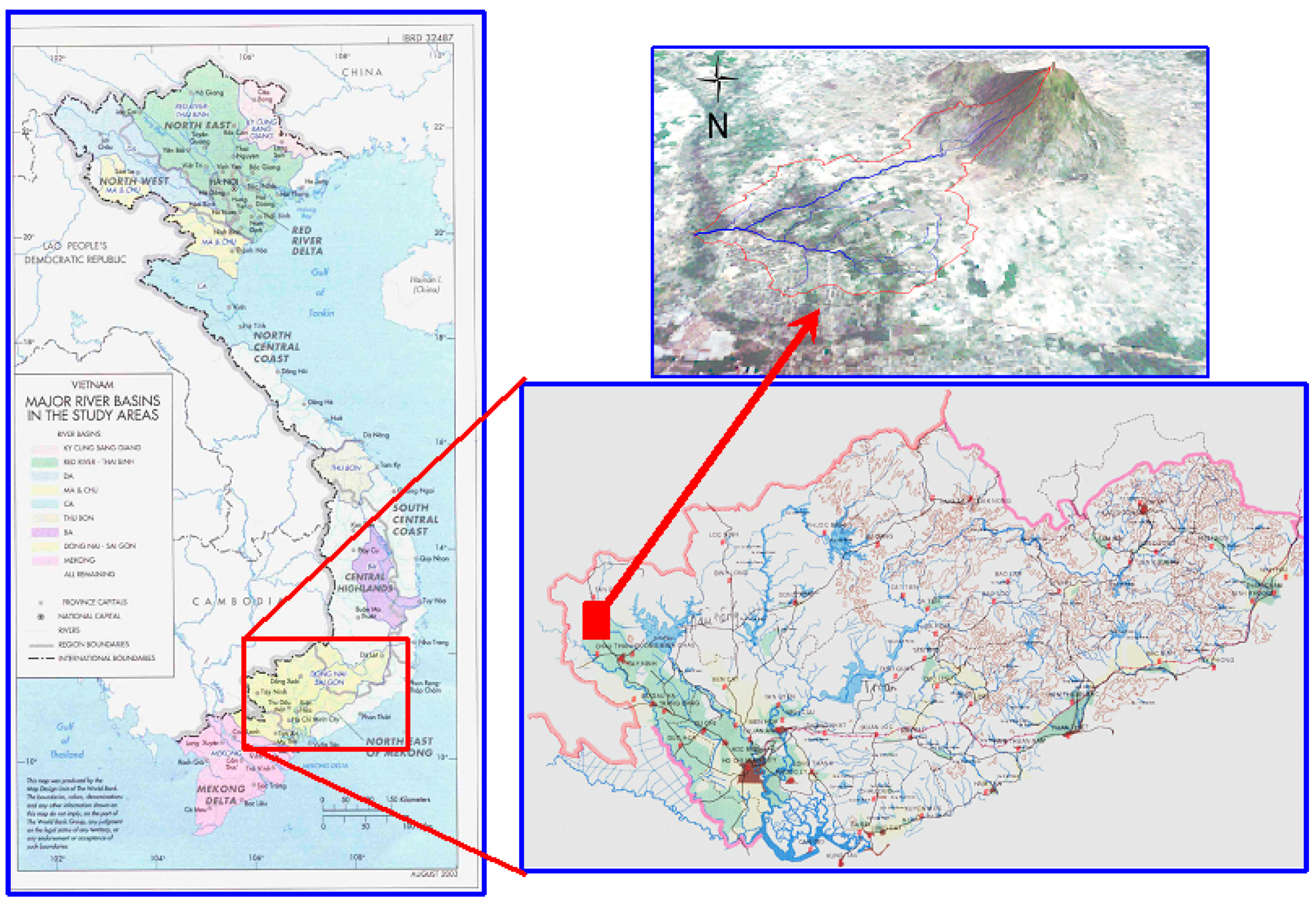
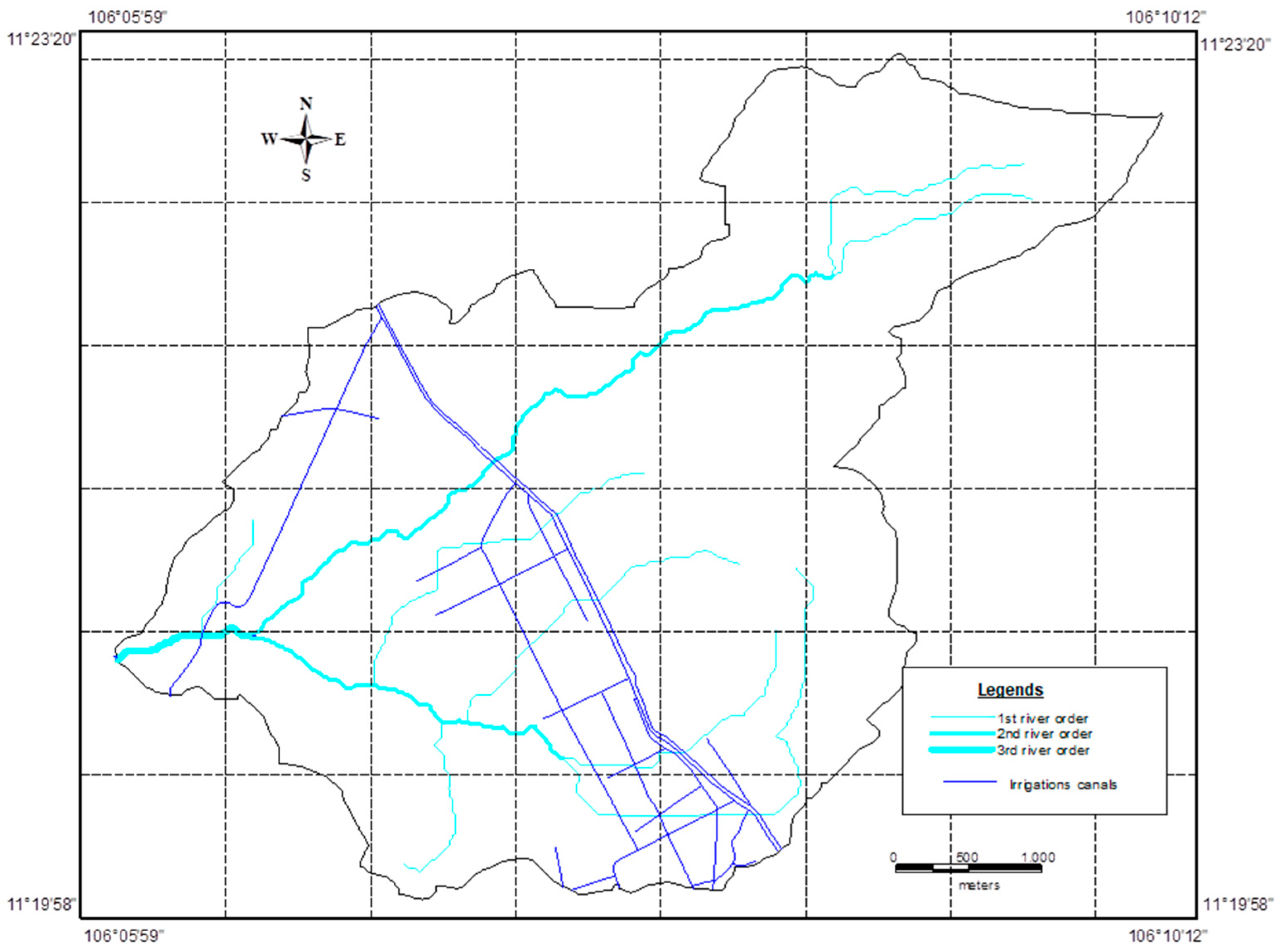
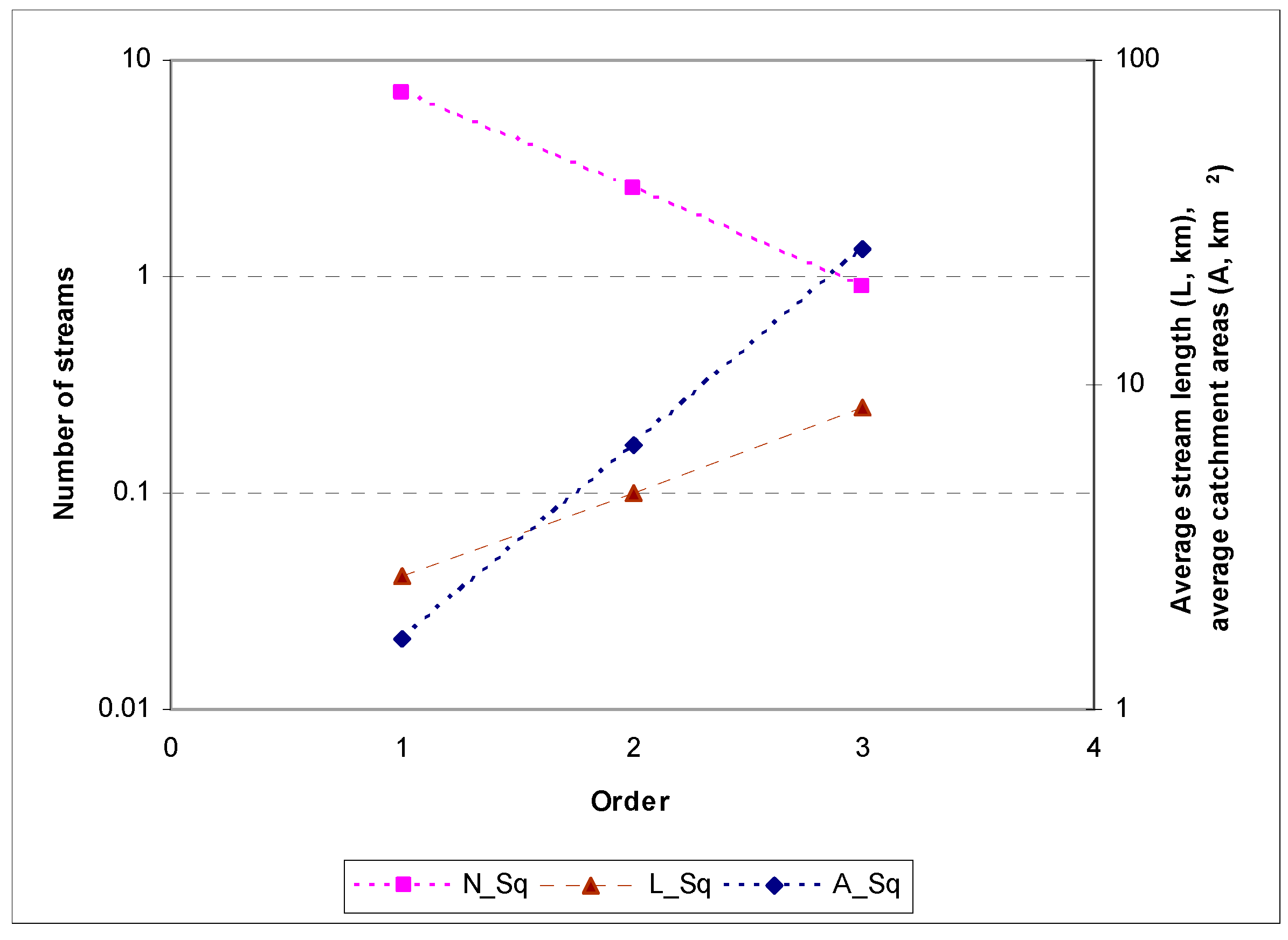
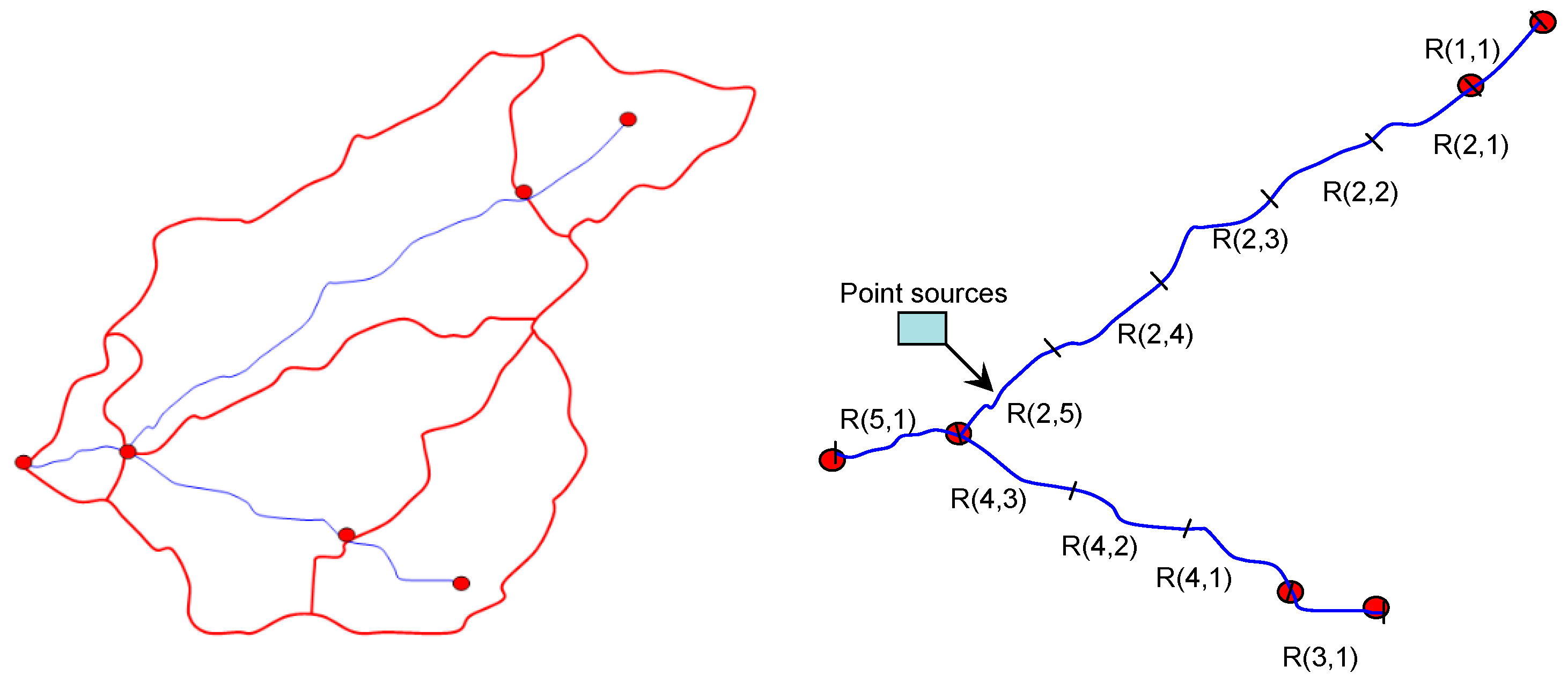
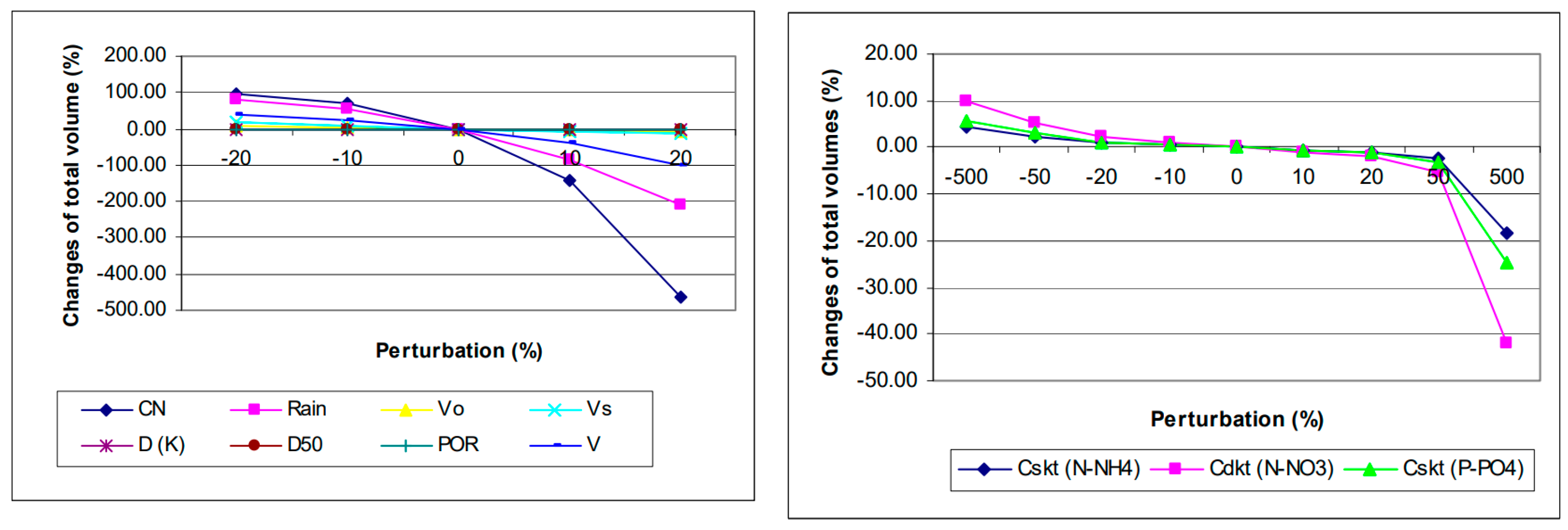
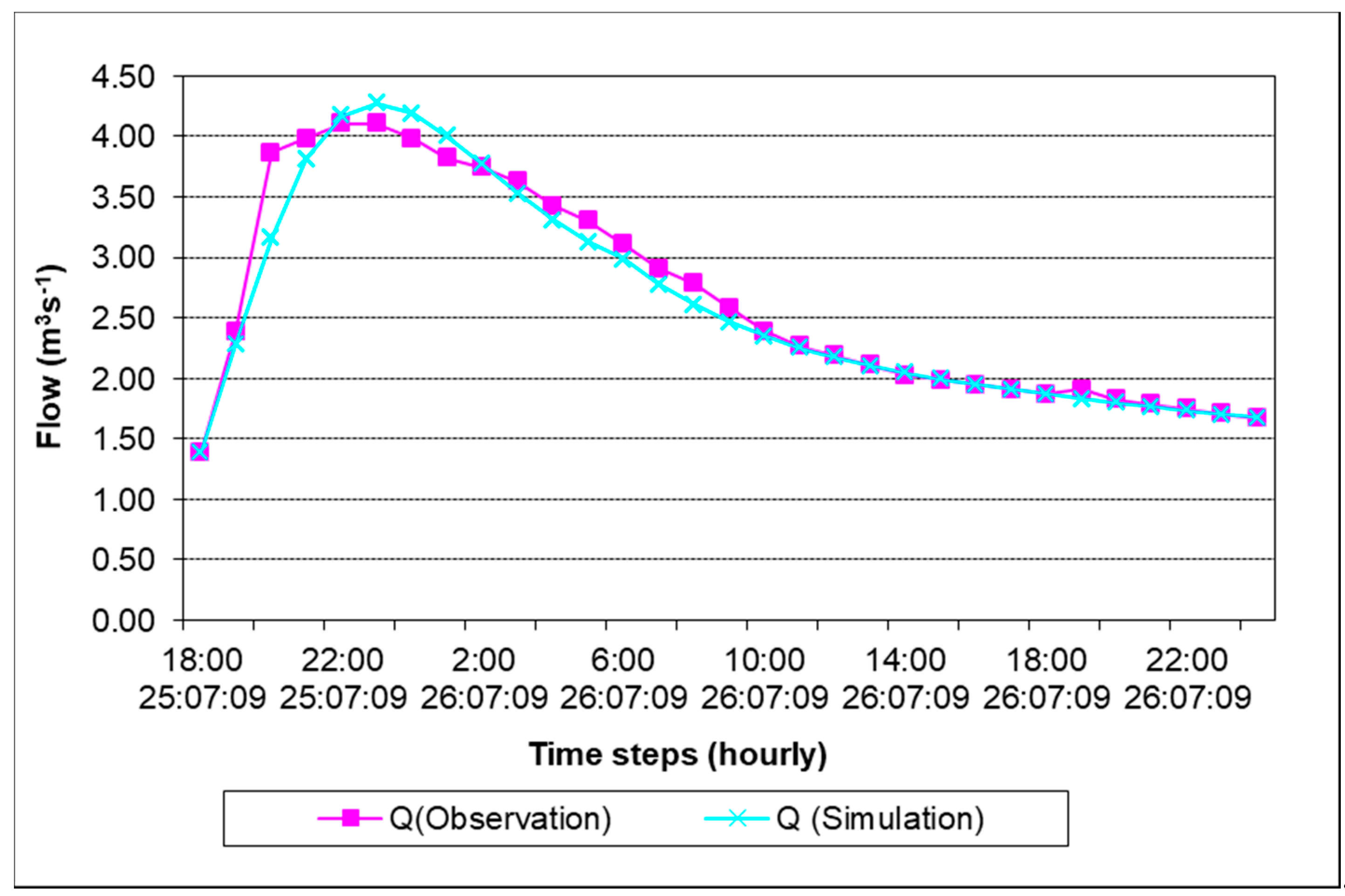
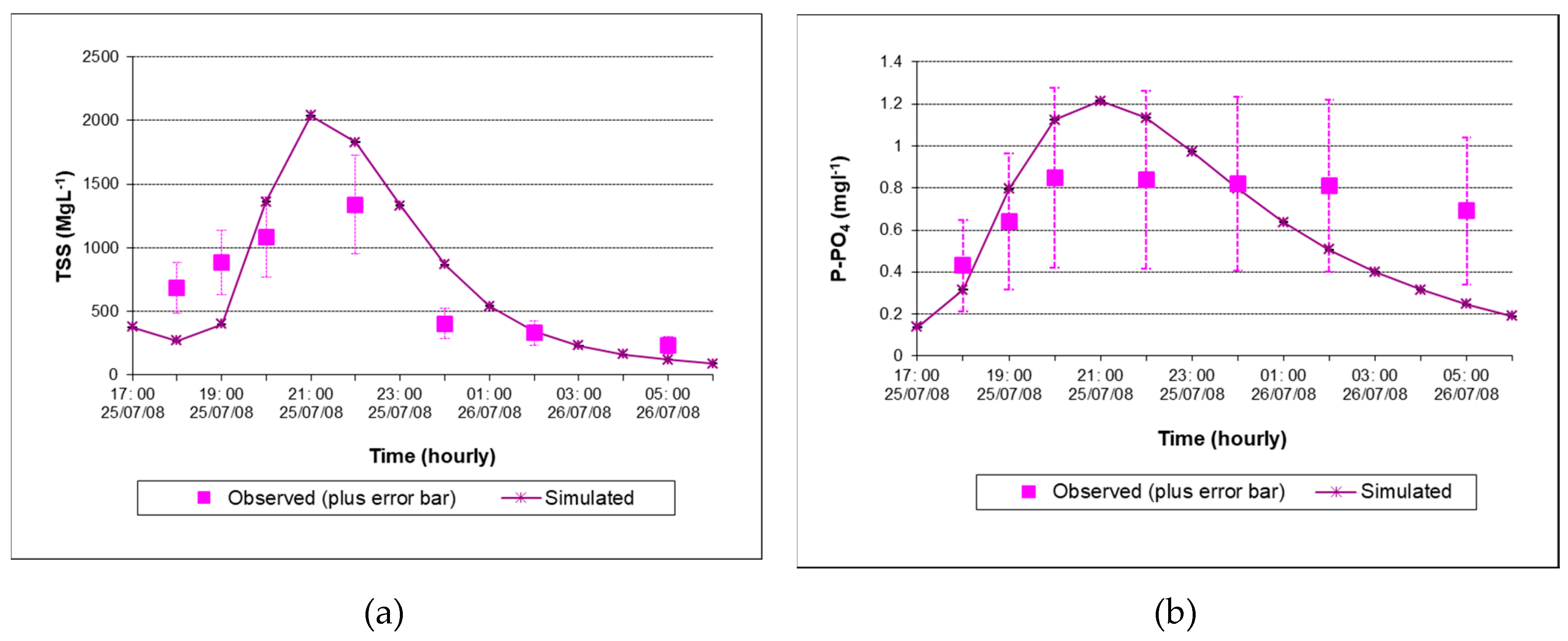
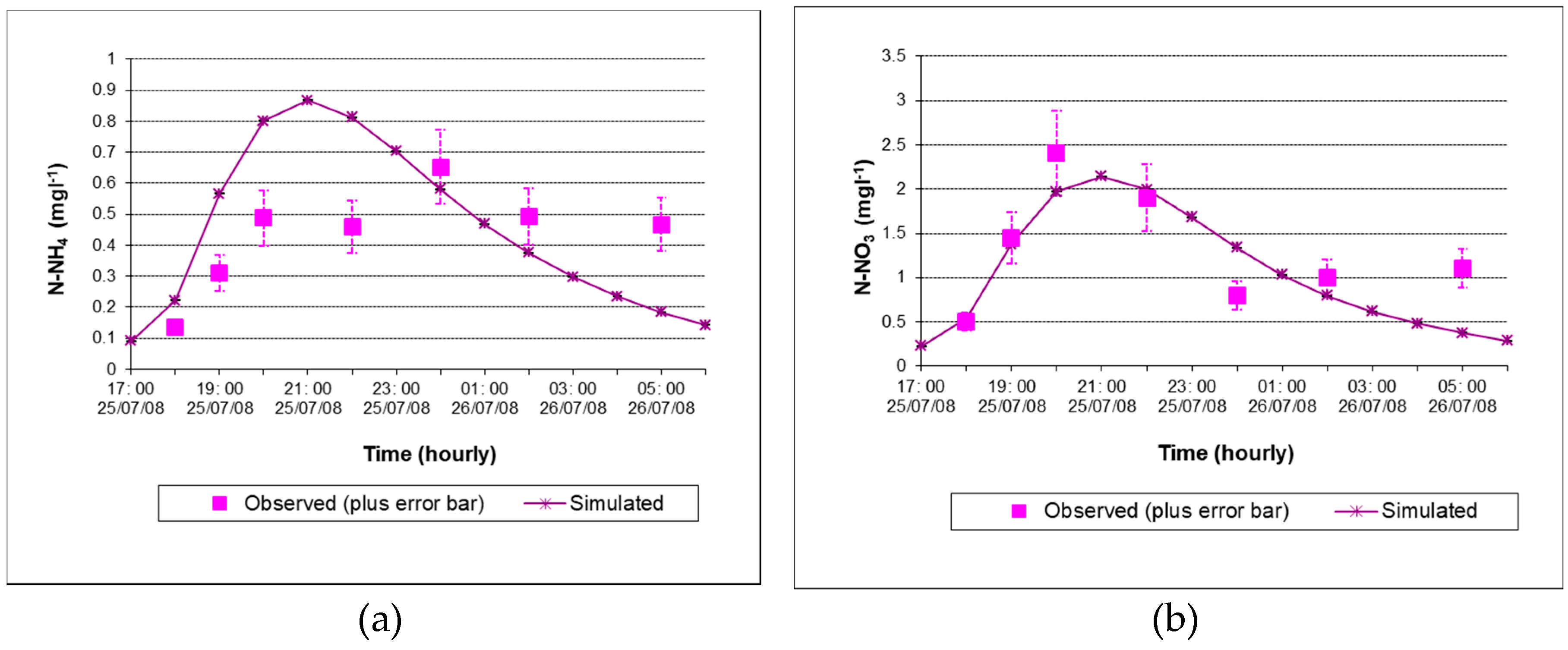
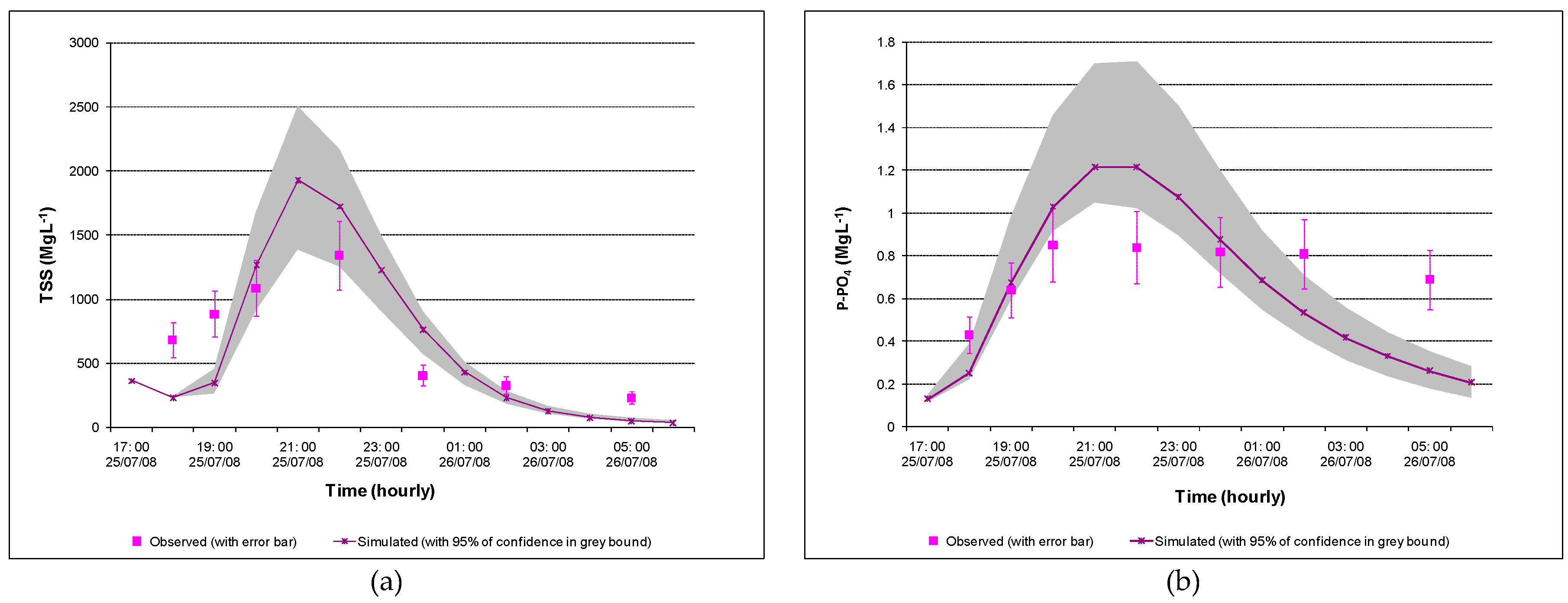
| Order | C1_N (number) | C1_L (km) | C1_A (km2) | C1_N_LSq (number) | C1_L_LSq (km) | C1_A_LSq (km2) | Horton’s Ratio | ||
|---|---|---|---|---|---|---|---|---|---|
| RB | RL | RA | |||||||
| 1 | 8 | 2.2 | 1.31 | 7.127 | 2.556 | 1.639 | 2.83 | 1.83 | 4.00 |
| 2 | 2 | 6.31 | 10.26 | 2.52 | 4.673 | 6.555 | |||
| 3 | 1 | 7.35 | 20.96 | 0.891 | 8.541 | 26.221 | |||
| Parameters | Notation | Units | Values |
|---|---|---|---|
| Coefficient in transport capacity relationship | A | 0.00066 | |
| Power in transport capacity relationship | B | 1.61 | |
| Power in the depth–discharge relationship parameter | B | 1.667 | |
| Overland flow resistance | Kf | 130.3 | |
| Water specific weight | Γ | kN/m3 | 9.80 × 103 |
| Density of water | P | kg/m3 | 1.00 × 103 |
| Gravity | G | m/s2 | 9.80 |
| Shields sediment function | Ø | 3.76 × 10−2 | |
| Shields criterion Reynolds number | R* | 4.66 | |
| Kinematic viscosity of water | N | m2/s | 1.00 × 10−6 |
| Slope (So) | Area (ha) | Overland Flow Length (m) | |
|---|---|---|---|
| Sub 1 | 0.210 | 266 | 272.80 |
| Sub 2 | 0.005 | 811 | 555.2 |
| Sub 3 | 0.006 | 389 | 262.4 |
| Sub 4 | 0.006 | 621 | 262.4 |
| Sub 5 | 0.002 | 87.9 | 60.0 |
| Sub-Catchment | D50 (*) | σ (*) | D (*) (kg/J) | GC (*) | CF (*) |
|---|---|---|---|---|---|
| Sub 1 | 0.0001 | 2.10 | 2.00 × 10−5 | 0.1–0.8(0.73) (**) | 0.35–0.9 (0.40) |
| Sub 2 | 0.0001 | 2.10 | 2.00 × 10−5 | 0–0.9 (0.55) | 0–0.9 (0.54) |
| Sub 3 | 0.0001 | 2.10 | 2.00 × 10−5 | 0–0.9 (0.68) | 0–0.9 (0.44) |
| Sub 4 | 0.0001 | 2.10 | 2.00 × 10−5 | 0–0.9 (0.47) | 0–0.9 (0.59) |
| Sub 5 | 0.0001 | 2.10 | 2.00 × 10−5 | 0.1–0.6 (0.47) | 0.5–0.9 (0.61) |
| Cdkt | Cskt | TDk | TSk | ||||
|---|---|---|---|---|---|---|---|
| P-PO4 | N-NH4 | N-NO3 | P-PO4 | N-NH4 | |||
| (mg/L) | (mg/L) | (mg/L) | (mg/L) | (mg/L) | |||
| Sub 1 | 0.0006 | 0.0004 | 0.02 | 0.11 | 0.05 | 1.00 | 0.305 |
| Sub 2 | 0.0014 | 0.0010 | 0.04 | 0.25 | 0.12 | 1.00 | 0.314 |
| Sub 3 | 0.0013 | 0.0008 | 0.03 | 0.23 | 0.10 | 1.00 | 0.240 |
| Sub 4 | 0.0018 | 0.0011 | 0.05 | 0.33 | 0.13 | 1.00 | 0.310 |
| Sub 5 | 0.0011 | 0.0011 | 0.05 | 0.2 | 0.13 | 1.00 | 0.371 |
| Reach | Length (m) | Number of Reservoirs | Average Flow Velocity (*)—V (m/s) | Travel Time per Reservoir—T (hours) |
|---|---|---|---|---|
| 1 | 1738 | 1 | 0.64 | 0.75 |
| 2 | 5536 | 5 | 0.48 | 0.64 |
| 3 | 1110 | 1 | 0.64 | 0.67 |
| 4 | 2639 | 3 | 0.48 | 0.51 |
| 5 | 1544 | 1 | 0.40 | 0.77 |
| Sub-Catchment | TSS | P-PO4 | N-NH4 | N-NO3 |
|---|---|---|---|---|
| Sub 1 | 72 | 0.054 | 0.036 | 0.108 |
| Sub 2 | 216 | 0.162 | 0.108 | 0.324 |
| Sub 3 | 72 | 0.054 | 0.036 | 0.108 |
| Sub 4 | 360 | 0.27 | 0.18 | 0.54 |
| Sub 5 | 1969 | 1.24 | 0.39 | 1.44 |
| Acronyms | Description | Range |
|---|---|---|
| Hydrology | ||
| CN | Curve number | ±20% |
| Rain | Rainfall (mm) | ±20% |
| Vo | Overland flow velocity (GIUH module) | ±20% |
| Vs | Average stream velocity (GIUH module) | ±20% |
| Erosion | ||
| K | Soil erodibility factor | ±20% |
| D50 | Median size of soil particle | ±20% |
| POR | Porosity of surface soil layer | ±20% |
| Nutrient Loading | ||
| Cdkt (N-NO3) | N-NO3 concentrations in dissolved forms | ±500% |
| Cskt (P-PO4) | P-PO4 concentrations in solid-phase forms | ±500% |
| Cskt (N-NH4) | N-NH4 concentrations in solid-phase forms | ±500% |
| River Routing | ||
| V | River reach velocity (Flow routing module) | ±20% |
| Point Sources | ||
| TSS | TSS point sources (hourly) | ±500% |
| P-PO4 | P-PO4 point sources (hourly) | ±500% |
| N-NH4 | N-NH4 point sources (hourly) | ±500% |
| N-NO3 | N-NO3 point sources (hourly) | ±500% |
| NSE | d | R2 | PBIAS | |
|---|---|---|---|---|
| Runoff Flow | 0.90 | 0.97 | 0.90 | 0.26 |
| TSS | 0.20 | 0.83 | 0.61 | 29.97 |
| P-PO4 | −1.04 | 0.78 | 0.71 | 3.48 |
| N-NH4 | 0.42 | 0.73 | 0.33 | 12.02 |
| N-NO3 | 0.10 | 0.76 | 0.42 | 19.44 |
| Acronyms | Description | Applied Values | (min; max) | |
|---|---|---|---|---|
| Hydrology | ||||
| CN | Curve number | Uniform | 54 | (52; 56) |
| Rain | Rainfall (mm) | Uniform | 40.5 | (38; 42) |
| Vo | Overland flow velocity (GIUH module) | Uniform | 0.04 | (0.03; 0.05) |
| Vs | Average stream velocity (GIUH module) | Uniform | 0.75 | (0.65; 0.8) |
| Erosion | ||||
| D (K) | Soil erodibility factor | Uniform | 0.14 | (0.1; 0.18) |
| D50 | Median size of soil particle | Uniform | 0.11 | (0.05; 0.15) |
| POR | Porosity of surface soil layer | Uniform | 0.6 | (0.5; 0.7) |
| Nutrient Loading | ||||
| Cdkt (NO3) | N-NO3 concentrations in dissolved forms | Uniform | 0.08 (*) | (0.02; 0.3) |
| Cskt (P-PO4) | P-PO4 concentrations in solid-phase forms | Uniform | 1 (*) | (1; 5) |
| Cskt (N-NH4) | N-NH4 concentrations in solid-phase forms | Uniform | 0.2 (*) | (0.04; 1) |
| River Routing | ||||
| V | River reach velocity (Flow routing module) | Uniform | 0.8 | (0.75; 0.85) |
| Point Sources | ||||
| TSS | TSS point sources (hourly) | Uniform | 50 | (30; 100) |
| P-PO4 | P-PO4 point sources (hourly) | Uniform | 0.8 | (0.5; 1) |
| N-NH4 | N-NH4 point sources (hourly) | Uniform | 0.6 | (0.4; 1) |
| N-NO3 | N-NO3 point sources (hourly) | Uniform | 1.2 | (0.6; 1.5) |
| Scenarios | Flow | TSS Peak | P-PO4 Peak | N-NH4 Peak | N-NO3 Peak | |
|---|---|---|---|---|---|---|
| NSE | mg/L | mg/L | mg/L | mg/L | ||
| 1 | CN | 0.85–0.95 | 1600–3450 | 1–2.3 | 0.72–1.6 | 1.8–4.1 |
| 2 | CN, rainfall | 0.85–0.95 | 700–3000 | 0.8–2.1 | 0.35–1.22 | 0.8–3 |
| 3 | CN rainfall, Vo | 0.85–0.95 | 1250–2820 | 0.78–1.62 | 0.55–1.2 | 0.12–2.95 |
| 4 | CN rainfall, Vo, Vs | 0.85–0.95 | 1450–3100 | 0.9–1.91 | 0.67–1.39 | 1.82–3.54 |
| 5 | CN rainfall, Vo, Vs, D(K) | 0.85–0.95 | 750–2500 | 0.68–1.72 | 0.63–1.37 | 1.74–3.44 |
| 6 | CN rainfall, Vo, Vs, D(K), D50 | 0.85–0.95 | 1550–32650 | 0.92–1.87 | 0.82–1.56 | 2.15–3.86 |
| 7 | CN rainfall, Vo, Vs, D(K), D50, POR | 0.85–0.95 | 1160–2840 | 0.37–1.31 | 0.67–1.39 | 1.05–2.76 |
| 8 | CN rainfall, Vo, Vs, D(K), D50, POR, Cdkt (NO3), Cskt (P-PO4), Cskt (N-NH4) | 0.85–0.95 | 810–2650 | 0.81–2.25 | 0.45–1.37 | 1.85–4.85 |
| 9 | CN rainfall, Vo, Vs, D(K), D50, POR, Cdkt (N-NO3), Cskt (P-PO4), Cskt (N-NH4), V | 0.85–0.95 | 600–2530 | 0.85–2.12 | 0.41–1.25 | 1.23–2.51 |
| 10 | CN rainfall, Vo, Vs, D(K), D50, POR, Cdkt (N-NO3), Cskt (P-PO4), Cskt (N-NH4), V, point sources (TSS, P-PO4, N-NH4, N-NO3) | 0.85–0.95 | 1400–2500 | 1.1–1.8 | 0.42–1.2 | 1.15–2.8 |
© 2019 by the authors. Licensee MDPI, Basel, Switzerland. This article is an open access article distributed under the terms and conditions of the Creative Commons Attribution (CC BY) license (http://creativecommons.org/licenses/by/4.0/).
Share and Cite
Nguyen, H.Q.; Meon, G.; Nguyen, V.T. Development of an Event-Based Water Quality Model for Sparsely Gauged Catchments. Sustainability 2019, 11, 1773. https://doi.org/10.3390/su11061773
Nguyen HQ, Meon G, Nguyen VT. Development of an Event-Based Water Quality Model for Sparsely Gauged Catchments. Sustainability. 2019; 11(6):1773. https://doi.org/10.3390/su11061773
Chicago/Turabian StyleNguyen, Hong Quan, Gunter Meon, and Van Thinh Nguyen. 2019. "Development of an Event-Based Water Quality Model for Sparsely Gauged Catchments" Sustainability 11, no. 6: 1773. https://doi.org/10.3390/su11061773
APA StyleNguyen, H. Q., Meon, G., & Nguyen, V. T. (2019). Development of an Event-Based Water Quality Model for Sparsely Gauged Catchments. Sustainability, 11(6), 1773. https://doi.org/10.3390/su11061773






